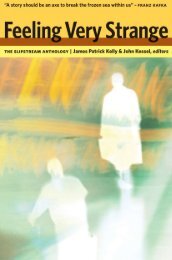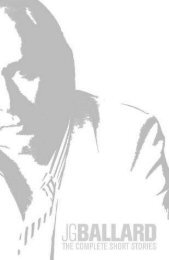The Curse of the Wer.. - Site de Thomas - Free
The Curse of the Wer.. - Site de Thomas - Free
The Curse of the Wer.. - Site de Thomas - Free
Create successful ePaper yourself
Turn your PDF publications into a flip-book with our unique Google optimized e-Paper software.
UPRIGHT CITIZENS ON ALL FOURS<br />
reality (or produce a unity) through recourse to oppositions. In this<br />
sense, an analysis that focuses solely on <strong>the</strong> ‘content’ <strong>of</strong> a monstrous<br />
representation such as <strong>the</strong> werewolf misses <strong>the</strong> point, because it will<br />
always lead back to <strong>the</strong> polarities that <strong>the</strong> monster has escaped. To<br />
explain fur<strong>the</strong>r: a content analysis <strong>of</strong> <strong>the</strong> werewolf produces an un<strong>de</strong>rstanding<br />
<strong>of</strong> lycanthropy as expressive <strong>of</strong> surface–<strong>de</strong>pth, nature–culture,<br />
conscious–unconscious oppositions. Yet, <strong>the</strong>re remains a sense in which<br />
<strong>the</strong>se categories cannot fully contain or explain <strong>the</strong> werewolf: for<br />
example, although <strong>the</strong> wolf is ‘hid<strong>de</strong>n’ in <strong>the</strong> person, you can also tell a<br />
werewolf by <strong>the</strong> eyebrows or <strong>the</strong> fingernails. Or, as in Vandover’s case,<br />
lycanthropy is a psychic affliction, but it is also written on <strong>the</strong> body.<br />
In this sense, Žižek’s schema may explain <strong>the</strong> bodily ‘excess’ that<br />
Russo has noted in <strong>the</strong> Gothic register. <strong>The</strong> body is a site where one<br />
<strong>of</strong> <strong>the</strong> ‘surpluses’ i<strong>de</strong>ntified by Žižek emerges; <strong>the</strong> body is never ‘just’<br />
a body, but also carries a ‘non-material but physical element’. This is<br />
what werewolves and o<strong>the</strong>r monsters remind us <strong>of</strong>, but it also suggests<br />
why <strong>the</strong> monstrous body always exceeds <strong>the</strong> oppositional categories that<br />
seek to contain and explain it. Fur<strong>the</strong>r, it may explain <strong>the</strong> amplification<br />
and diversification <strong>of</strong> monstrosity in mo<strong>de</strong>rnity, because as each<br />
spectral manifestation is assimilated into social ‘reality’ (through<br />
<strong>the</strong> explanations <strong>of</strong> comparative mythologists or literary <strong>the</strong>orists,<br />
for example), new spectres emerge which must outdo <strong>the</strong> excesses <strong>of</strong><br />
<strong>the</strong>ir pre<strong>de</strong>cessors.<br />
Certainly, <strong>the</strong> body <strong>of</strong> <strong>the</strong> werewolf became increasingly excessive<br />
as <strong>the</strong> nineteenth century wore on. Although Reynolds had <strong>de</strong>veloped<br />
<strong>the</strong> horror <strong>of</strong> <strong>the</strong> transformation scene as early as 1846, Wagner <strong>the</strong><br />
Wehr-wolf was not <strong>de</strong>picted as especially aggressive once he assumed<br />
wolf form, causing <strong>de</strong>aths as a result <strong>of</strong> <strong>the</strong> speed with which he rushed<br />
about as a wolf, ra<strong>the</strong>r than through acts <strong>of</strong> gratuitous violence (Figure<br />
4). Marryat’s 1839 story had <strong>de</strong>picted a monster <strong>of</strong> more evil intent<br />
in <strong>the</strong> werewolf Christina, and subsequent female lycanthropes were<br />
consistently nasty in <strong>the</strong>ir wolfish incarnations. While imagery <strong>of</strong> <strong>the</strong><br />
ferocious female werewolf persisted in fiction throughout <strong>the</strong> period <strong>of</strong><br />
<strong>the</strong> fin <strong>de</strong> siècle, her combination <strong>of</strong> intelligence and <strong>de</strong>monic intent<br />
was also increasingly emphasized in discussions by folklorists and<br />
61





